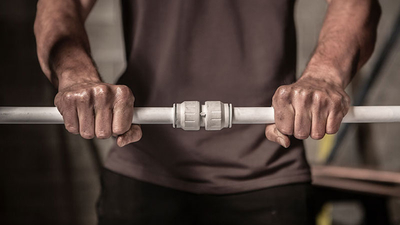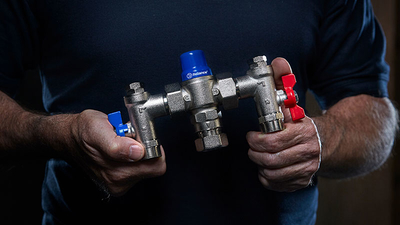Simplifying bathroom installations

With bathroom designs, housing and consumer needs having changed beyond recognition over the years, installers must be prepared for evolution in order not to be left behind. New, modern bathrooms require a smarter selection of fittings and pipes to meet changing installation challenges.
Houses are getting smaller, aesthetic preferences are changing and regulations are becoming increasingly stringent. We take a look at five challenges affecting installers and our top product picks to help installers stay ahead of the curve.
Smaller home, smaller bathroom
Take any new build and you’ll find compact living spaces as the norm, with bathrooms getting ever smaller. To plumb these modern bathrooms plastic- pipes that are easy to bend and manoeuvre, compared to copper-based equivalents, offer more flexibility for installers with less space to work in.
JG Speedfit’s plastic push-fit fittings and pipes that can be installed quickly and easily in tight spaces, without the need for tools, perfectly complement any installation in modern bathrooms.

Change with the times
As jobs become familiar, it is easy to fall into a routine of recommending the same solutions over and over. However, with changes in cylinders and WCs, a more tailored approach is now necessary to keep plumbing systems efficient.
Traditional tank fed hot water systems used 22mm feeds to a bath as the available pressure was typically low, being dictated by the height of the tank in relation to the tap being used. We then saw the introduction of combi boilers, and the resultant drop in flow rates made the 22mm feed pipe redundant, and instead a 15mm hot water feed to a bath became the more common choice.
However, for larger properties, the low flow rates available with most combination boilers are restrictive, so to combat this, manufacturers introduced pressurised cylinders that stored large volumes of hot water under pressure. The 22mm hot water pipes came back into the picture for larger properties, to handle the extra volume of water flowing from these pressurised cylinders.
Many plumbers now realise that feeding a WC with a 15mm cold main is not necessary. Ball valve orifices and the small volumes of water needed to flush the toilet means that a 10mm pipe is more appropriate as well as being easier to hide from sight.
Whichever way the industry turns, it is essential that installers adapt their installation practices to stay at par with the changing times.

Time is money
With time at a premium, simple and efficient solutions that streamline installations are invaluable to installers. Switching from traditional to push-fit plumbing is one way installers can claw back on time – taking out the lengthy and risky process of soldering. Unlike copper, push-fit fittings don’t need special tools to make a secure, leak-proof connection. They also allow for easy dismounting, without the need for tools, if some alterations to the pipework need to be made. JG Speedfit, for example, offers a wide range of fittings, pipe, tap connectors, service valves and appliance taps blending push-fit and multi-seal technology.

The power of regulations
Aside from aesthetic trends, installers must consider water regulations when thinking about plumbing bathrooms. For example, Part G of the Building Regulations was updated in 2010, stating that the bath tap must be controlled at no more than 48°C.
One way to safely guarantee this temperature is not exceeded, is to fit a form of thermostatic control on all baths e.g. a Thermostatic Mixing Valve (TMV). This is also extended to renovations under the new guidelines and must be complied with. As well as reducing the risk of scalding, TMVs eliminate bacteria growth by enabling hot water to be stored at higher temperatures. Reliance Valves’ Easifit TMV, for example, eliminates the risk of accidental injuries and burns by precisely blending hot and cold water to a safe and comfortable temperature.

Hidden features
Exposed pipework, unless used as a design feature, is often a no-no in today’s world. Not only is bulky pipework an eyesore, it can also be dangerous, especially if hot water is running through them. Pipework must now be installed with limited access, which can be a challenge for installers. A prime instance is with bathroom basins.
Bathroom basins used to be freestanding, however installers are now being challenged to build them into the wall, along with the pipework supplying them.
To help accomplish recessed or semi-recessed installations, JG Speedfit’s flexi hoses range, that can directly connect with the basin tap from one end and with main’s water supply – using push-fit mechanism – from the other end help make installers’ lives easier and installations quicker.
Discover more
Explore our complete range of JG Speedfit and Reliance Valves products.
